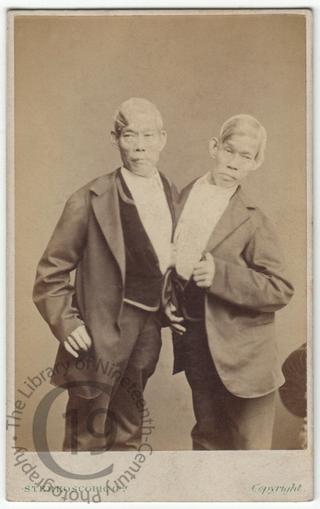
Chang and Eng Bunker
The original Siamese twins, Chang and Eng Bunker, were in fact born of Chinese parents, and were known as ‘the Chinese Twins’ in the village on the banks of the Mekon (modern-day Thailand) where they were born on 11 May 1811. Joined by a small band of cartilage at the sternum, in time they were eventually able to stretch the tissue by which they were joined so that they could stand side-by-side rather than face-to-face. The twins’ livers were also fused, though they were independently complete.
At the age of seventeen, the boys were brought to America by Boston sea captain Abel Coffin, who had contracted to manage them as a touring exhibit. After three years in America, the twins took control of their own careers, earning a very good living touring the world. Their association with P.T. Barnum at this stage in their lives is often exaggerated. Barnum displayed wax figures of the twins in his American Museum during the 1840s and published a pamphlet with biographical details in 1853.
By 1839 they had earned enough money to retire and the twins settled in North Carolina where they grew tobacco. In 1844 they adopted the surname Bunker in honour of the battle of Bunker Hill in the American War of Independence, their own original Siamese surname having been lost when they left their homeland.
Chang and Eng married a pair of sisters, Adelaide and Sarah Anne (or Sally) Yates. The two couples lived on adjacent farms, the husbands spending alternate nights with their own wives in their own houses. Between them, they fathered a total of 22 children (10 were Chang’s and 12 were Eng’s), though not all of them survived infancy.
With large families to support, Chang and Eng returned to show business in 1860, agreeing to a six-week engagement at Barnum’s American Museum. After suffering financial losses during the American Civil War, the brother’s agreed to a European tour sponsored by Barnum in 1868.
In 1874 Chang, a heavy drinker, contracted pneumonia. He died suddenly dying the night of January 17. Eng woke to find his brother dead. A doctor was summoned to perform an emergency separation, but by the time he arrived, Eng had died too. Their fused liver, the only organ they shared, is still preserved at the Mutter Museum in Philadelphia, along with a plaster of their heads and torsos.
Photographed by the London Stereoscopic and Photographic Company.
Entered at Stationers’ Hall on 1 March 1869 by George Swan Nottage of Sidmouth.
Code: 127470




